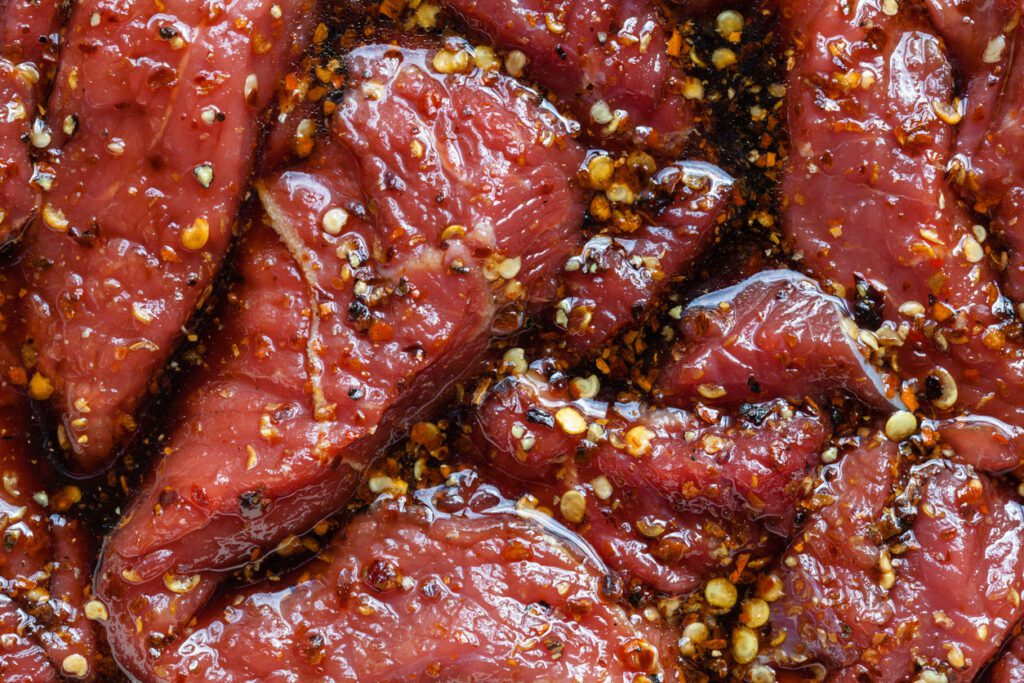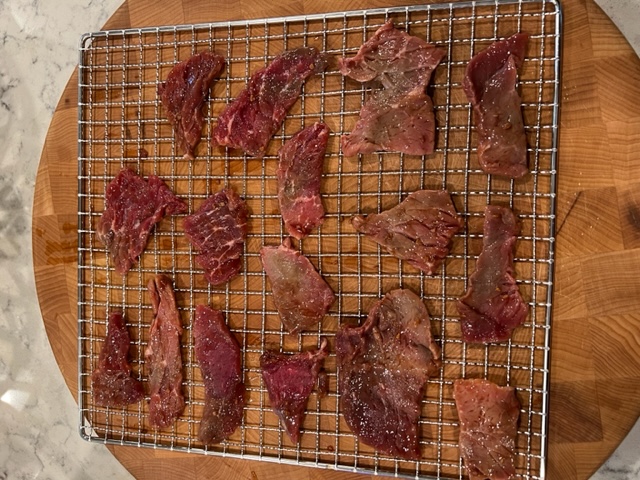Are you craving a delicious, protein-packed snack dish to enjoy? May I suggest homemade beef jerky? Although it may initially sound intimidating, making beef jerky is relatively easy. Whether it’s for a party or to have around the house as a constant snack option, homemade beef jerky will be sure to satisfy even the pickiest eaters!
Gather Your Ingredients – What you’ll need to make the beef jerky.
Making homemade beef jerky can be a fantastic and healthy snack option, but before you can start, you’ll need to gather some key ingredients. You’ll need a lean cut of beef, such as sirloin or flank steak, along with seasonings like salt, pepper, and garlic powder. In addition, you’ll need a marinade, which can be made at home out of soy sauce and Worcestershire sauce. To get even more creative with your recipe and add extra flavor to the final product, consider adding other spices, such as red pepper flakes or smoked paprika. Once your ingredients are ready, you can begin making delicious homemade beef jerky!
Prepare the Meat – Cutting and trimming the meat for your jerky
Preparing the meat for beef jerky can be a smooth process. Start by selecting a lean cut of meat, such as top round or eye of round, since these are healthier cuts that also work well for making jerky. Then, grab your knives to ensure you get an even slice with each pass. Next, cut the meat against the grain if you prefer your jerky chewier and softer or with the grain if you want it crunchier and tougher. Once you have the desired thickness slices, you can use a cheese grater to tenderize them further before cooking. Lastly, trim any fat away since that can become rancid during dehydration, resulting in unsafe jerky!
Slice The Meat – How to cut the meat into thin strips, perfect for jerky.
Making homemade beef jerky is a great way to enjoy a delicious and healthy snack. To get the perfect thin strips ideal for jerky, start by slicing the meat against the grain. This is important because it ensures the jerky comes out tender instead of chewy and tough. A sharp knife and a steady hand will give you thin layers with smooth edges to help make ideal beef jerky slices. Don’t be afraid to experiment to see which thickness of slices you like best – remember that thinner pieces will dehydrate faster!
Marinade Time – Add your spices and seasoning to create a unique flavor
Making beef jerky at home is a great way to enjoy a healthy snack without added preservatives. Before dehydrating, you’ll need to marinate the beef with the spices and seasonings of your choice. Then, building upon classic flavor combinations such as cayenne pepper, chili powder, paprika, and ground mustard, you can create a unique taste experience by highlighting just the right notes. Then, with some creativity and experimentation, you can make delicious beef jerky quickly!


Set Up Your Dehydrator – Tips on how to set up your dehydrator for optimal results.
Setting up your dehydrator for making healthy beef jerky is simple! When preparing for the process, it’s essential to arrange your racks and trays so that air can flow freely throughout the inside of the dehydrator. Next, place your beef evenly on each tray and make sure none of them are overlapping. Taking these steps helps ensure you get maximum drying power with your dehydrator and will give you delicious, healthy homemade beef jerky in no time!
Note: I only had enough strips of meat to fill three racks, so I staggered the placement to allow for better airflow.
Start Dehydrating – The importance of maintaining proper temperature and airflow throughout the dehydrating process.
Maintaining proper temperature and airflow throughout the dehydrating process of making beef jerky is essential for creating a healthy and safe product. The temperature must remain consistent so the beef is dried evenly without over-cooking. Air flow must also be managed well – if the meat isn’t adequately ventilated, that can lead to increased bacterial growth and spoilage. Understanding how these two elements affect each other during dehydration will significantly impact the final product, making it better-tasting and healthier.


Trying your hand at homemade beef jerky can be a challenging but rewarding experience. Following these steps takes time and requires patience, but the final result is worth it when you sink your teeth into that deliciousness of homemade jerky! You get to choose the ingredients and make an original marinade for a unique taste – no two batches have to be the same. You’ll master the relationship between temperature, airflow, and duration as you experiment to find the best flavor. Not only are the results yummy enough to eat, but you can also create enough for friends and family to share!



I found the following recipe on the Fox Valley Foodie website.
Homemade Beef Jerky in a Dehydrator
Fox Valley Foodie. https://www.foxvalleyfoodie.com/homemade-beef-jerky/
Ingredients
2 pounds beef eye of round (thinly sliced)
Jerky Marinade
- ⅔ cup Worcestershire sauce
- ⅔ cup Soy sauce
- 1 teaspoon Liquid smoke
- 1 tablespoon Smoked paprika
- 1 tablespoon Brown sugar
- 2 teaspoons Freshly ground black pepper
- 1 teaspoon Cayenne pepper
- 1 teaspoon Garlic powder
- 1 teaspoon Onion powder
Instructions
- (Optional) Place beef in the freezer for two hours. It will be easier to slice thinly.
- Slice beef thinly against the grain. (approximately ⅛”)
- Add all marinade ingredients into a bowl and mix to combine.
- Place sliced beef in a ziplock plastic bag (gallon sized) and pour in the marinade. Ensure it evenly coats the meat and place it in the refrigerator overnight.
- Remove beef from the bag and pat dry with paper towels (drying with a paper towel will speed up cooking time). Discard the excess marinade.
- Lay the jerky strips in a single layer on dehydrator trays and set your food dehydrator at 165 degrees F.
- Dehydrate for 6 hours or until the beef jerky is dry and cracks when you bend it.
Thank you for reading this blog post, and if you have any questions or comments, please leave them in the Comments section below.
Copyright © 2019 I Don’t Know All The Answers, Nikki Mastro.
All of my photographs and documents are Copyrighted.
No part of this website, including text, photographs, and documents, may be reproduced, stored in a retrieval system, or transmitted in any form or by any means without written permission from the copyright holder. All unauthorized use is strictly prohibited. If you choose to copy or share any information from my site, you must provide a link to the source. I appreciate your cooperation.

